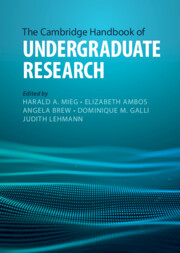Book contents
- The Cambridge Handbook of Undergraduate Research
- The Cambridge Handbook of Undergraduate Research
- Copyright page
- Contents
- Figures
- Tables
- Contributors
- Foreword
- Foreword
- 1 Introduction
- Part I Theory and Research on Undergraduate Research
- Part II Implementation, Approaches, Methods
- Part III Disciplines
- 17 Introduction
- Part III.1 STEM
- Part III.2 Health
- Part III.3 Social Sciences
- Part III.4 Humanities
- Part III.5 Arts & Design
- Part III.6 Disciplines A–Z
- 40 Undergraduate Research in Business Schools
- 41 Undergraduate Research in Early Childhood Education
- 42 Undergraduate Research in Geography
- 43 Undergraduate Research in Legal Studies
- 44 Undergraduate Research in Social Work Education
- 45 Approaches to Undergraduate Research in Sustainability
- 46 Undergraduate Research in Teacher Education
- Part IV International Perspective
- Part V Avenues for Developing Undergraduate Research
- Index
- References
45 - Approaches to Undergraduate Research in Sustainability
from Part III.6 - Disciplines A–Z
Published online by Cambridge University Press: 11 August 2022
- The Cambridge Handbook of Undergraduate Research
- The Cambridge Handbook of Undergraduate Research
- Copyright page
- Contents
- Figures
- Tables
- Contributors
- Foreword
- Foreword
- 1 Introduction
- Part I Theory and Research on Undergraduate Research
- Part II Implementation, Approaches, Methods
- Part III Disciplines
- 17 Introduction
- Part III.1 STEM
- Part III.2 Health
- Part III.3 Social Sciences
- Part III.4 Humanities
- Part III.5 Arts & Design
- Part III.6 Disciplines A–Z
- 40 Undergraduate Research in Business Schools
- 41 Undergraduate Research in Early Childhood Education
- 42 Undergraduate Research in Geography
- 43 Undergraduate Research in Legal Studies
- 44 Undergraduate Research in Social Work Education
- 45 Approaches to Undergraduate Research in Sustainability
- 46 Undergraduate Research in Teacher Education
- Part IV International Perspective
- Part V Avenues for Developing Undergraduate Research
- Index
- References
Summary
Sustainability science education research since the work of Kates et al. (2001) suggests that, despite uncertainties regarding the field and its methods, students are engaged in sustainability research, gain confidence when faced with a real-world problem to address, and learn to interact effectively with stakeholders in a team situation. Sustainability science education also benefits from introducing students to interdisciplinarity and wicked problem-solving. Challenges include the lack of agreement on what sustainability education entails, institutional resistance to interdisciplinary approaches, staffing and funding, lack of administrative support, and identifying and assessing key competencies. However, despite the challenges, there are several notable approaches developed and programs initiated for undergraduates.
Keywords
- Type
- Chapter
- Information
- The Cambridge Handbook of Undergraduate Research , pp. 423 - 430Publisher: Cambridge University PressPrint publication year: 2022



